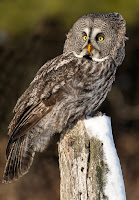GREAT GREY OWL
GREAT GREY OWL – (Strix nebulosa) – (See images below)
DESCRIPTION: The Great Grey Owl adult has a mottled grey-brown plumage. Facial disk is very large and finely barred and greyer than rest of body. Eyes are yellow. Wings are heavily barred. There is a small whitish bow tie with a black middle. Under parts show some brown and light grey stripes or bars. Hooked bill is yellow-orange. Legs and feet are covered in feathers. As with other owls, females are larger. Juveniles have more brown in their plumage. Bird length is around 66 cm (26 inches).
VOICE: https://www.xeno-canto.org/species/Strix-nebulosa
NAME: ‘Owl’ is an onomatopoeia for the bird’s call and comes from Cockney. Latin genus name ‘Strix’ stems from Greek mythology and refers to a screech owl that was ‘sucking the blood of humans’ (Helm). Latin species name ‘nebulosa’ means ‘dark’.
HABITAT: Boreal forest.
DIET: Mainly small rodents and birds. Usually hunts around dawn and dusk, can catch prey by sound under the snow.
NESTING: Nest is built in a tree, generally in an abandoned nest. From three to five white eggs are laid, incubated by female. Chicks fed by female at first. Parents are apparently able to scare away nest predators as large as a black bear.
DISTRIBUTION: Year-round resident worldwide in boreal forests and the taiga (except eastern half of Ontario, Quebec and the Atlantic region of Canada, Norway and Sweden). Also in small areas in the northwest region of USA.
Distribution Map: https://en.wikipedia.org/wiki/Great_grey_owl#/media/File:Bartkauz-Strix_nebulosa-World.png
ON PEI: Does not breed on Prince Edward Island, sightings listed as ‘accidental’ so far. See note below on bird vagrancy.
CONSERVATION: Population widespread, not currently at risk. A potential threat is habitat loss due to logging operations.
NOTES: The great grey owl is the provincial bird of Manitoba.
This species is the largest owl in terms of length but not the heaviest.
Vagrancy: In biology this means an animal going way outside its normal range. For birds, this can happen when there are storms and they get blown off course. On other times, the bird simply wanders in a different direction than usual. Here’s an article about vagrancy in birds.
SIMILAR SPECIES: Barred Owl, Great Horned Owl
REFERENCES: https://www.borealbirds.org/bird/great-gray-owl
http://identify.whatbird.com/obj/6/overview/Great_Gray_Owl.aspx
http://fieldguide.mt.gov/speciesDetail.aspx?elcode=ABNSB12040 (Montana Field Guide)
https://animaldiversity.org/accounts/Strix_nebulosa/ (University of Michigan)
http://www.luontoportti.com/suomi/en/linnut/great-grey-owl (Nature Gate Finland)
https://birdatlas.mb.ca/accounts/speciesaccount.jsp?sp=GGOW&lang=en (Manitoba Breeding Bird Atlas)
https://www.audubon.org/field-guide/bird/great-gray-owl
https://www.owlpages.com/owls/species.php?s=1770
https://en.wikipedia.org/wiki/Great_grey_owl
DESCRIPTION: The Great Grey Owl adult has a mottled grey-brown plumage. Facial disk is very large and finely barred and greyer than rest of body. Eyes are yellow. Wings are heavily barred. There is a small whitish bow tie with a black middle. Under parts show some brown and light grey stripes or bars. Hooked bill is yellow-orange. Legs and feet are covered in feathers. As with other owls, females are larger. Juveniles have more brown in their plumage. Bird length is around 66 cm (26 inches).
VOICE: https://www.xeno-canto.org/species/Strix-nebulosa
NAME: ‘Owl’ is an onomatopoeia for the bird’s call and comes from Cockney. Latin genus name ‘Strix’ stems from Greek mythology and refers to a screech owl that was ‘sucking the blood of humans’ (Helm). Latin species name ‘nebulosa’ means ‘dark’.
HABITAT: Boreal forest.
DIET: Mainly small rodents and birds. Usually hunts around dawn and dusk, can catch prey by sound under the snow.
NESTING: Nest is built in a tree, generally in an abandoned nest. From three to five white eggs are laid, incubated by female. Chicks fed by female at first. Parents are apparently able to scare away nest predators as large as a black bear.
DISTRIBUTION: Year-round resident worldwide in boreal forests and the taiga (except eastern half of Ontario, Quebec and the Atlantic region of Canada, Norway and Sweden). Also in small areas in the northwest region of USA.
Distribution Map: https://en.wikipedia.org/wiki/Great_grey_owl#/media/File:Bartkauz-Strix_nebulosa-World.png
ON PEI: Does not breed on Prince Edward Island, sightings listed as ‘accidental’ so far. See note below on bird vagrancy.
CONSERVATION: Population widespread, not currently at risk. A potential threat is habitat loss due to logging operations.
NOTES: The great grey owl is the provincial bird of Manitoba.
This species is the largest owl in terms of length but not the heaviest.
Vagrancy: In biology this means an animal going way outside its normal range. For birds, this can happen when there are storms and they get blown off course. On other times, the bird simply wanders in a different direction than usual. Here’s an article about vagrancy in birds.
SIMILAR SPECIES: Barred Owl, Great Horned Owl
REFERENCES: https://www.borealbirds.org/bird/great-gray-owl
http://identify.whatbird.com/obj/6/overview/Great_Gray_Owl.aspx
http://fieldguide.mt.gov/speciesDetail.aspx?elcode=ABNSB12040 (Montana Field Guide)
https://animaldiversity.org/accounts/Strix_nebulosa/ (University of Michigan)
http://www.luontoportti.com/suomi/en/linnut/great-grey-owl (Nature Gate Finland)
https://birdatlas.mb.ca/accounts/speciesaccount.jsp?sp=GGOW&lang=en (Manitoba Breeding Bird Atlas)
https://www.audubon.org/field-guide/bird/great-gray-owl
https://www.owlpages.com/owls/species.php?s=1770
https://en.wikipedia.org/wiki/Great_grey_owl
 |
| Great grey owl, Peter K. Burian |
 |
| Great grey owl, ON, jok2000 |
 |
| Great grey owl juvenile by Peter K. Burian |